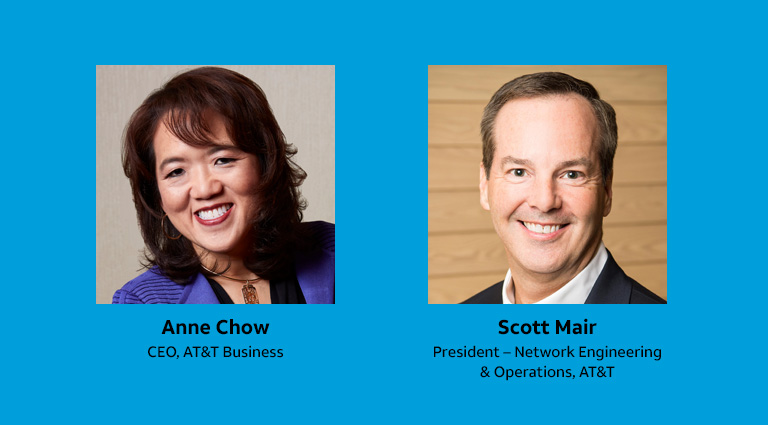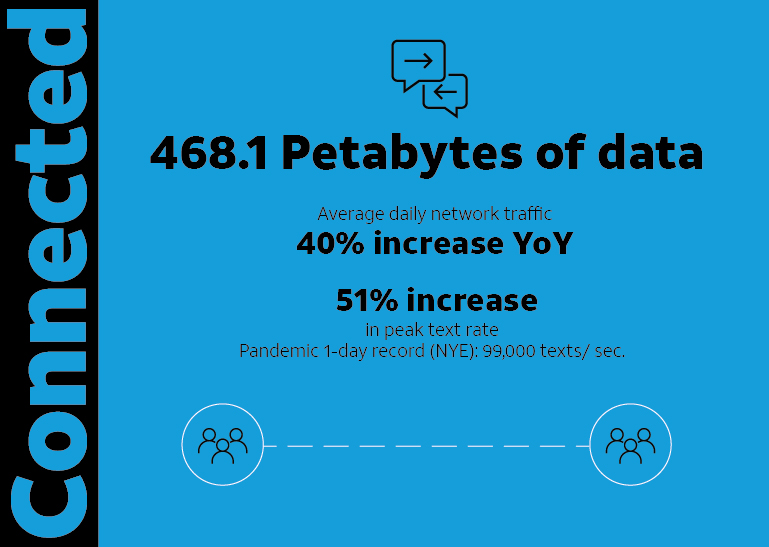
It’s safe to say none of us saw last year coming. And the changes we’ve all experienced have been profound and ongoing. But while the pandemic scrambled everyone’s plans, AT&T’s commitment to reliability, resiliency, and outstanding service for our clients never wavered. As so much of the world felt like it was tearing at the seams, we knew our network, services, and people had to hold strong for our customers.
Here’s how we did it. And how we’re ensuring we’re ready for whatever comes next.
Connected across the network
One of the biggest and most immediate challenges we faced was the soaring demand for virtual connections as physical connections had to be put on hold. On an average day now, about 468 petabytes of data crosses our network, up 40% year-over-year. That’s the equivalent of streaming nearly 100 million two-hour long movies in HD – a number that may feel like reality for some people.

But this wasn’t just about streaming movies and playing games, as vital as those comforts were and are. Those numbers also contain countless videoconferences done from living rooms, school tests taken from kitchen tables, lessons taught from classrooms to dining rooms, business transformations, virtual doctor visits via telemedicine, and calls for aid from first responders.
Reliability for businesses & at-home workers
The number of companies – from the biggest corporations to local small businesses – that had to pivot to a work-from-home model almost literally overnight presented a technical challenge that no one had ever seen before. But we’ve been working with these companies for years, and our objectives have always been to anticipate their needs and dynamically support their operations. So when those customer calls, texts, and emails started flooding in, we had the resources and experience to help them make that transition in incredibly agile ways. While other providers are talking about what they’re going to do to support businesses, the fact of the matter is AT&T has already been supporting businesses and their changing needs long before the COVID-19 pandemic and we’ll continue to do so.
For example, the right data plans were critical for our customers. (Hint: Shared, pooled rate plans are vital for thousands of businesses across every vertical industry. Just ask them.)
Rich Shaw, vice president of Voice and Collaboration in AT&T Business, goes into more detail today on just how dramatically businesses had to change when COVID hit and how we adapted right along with them.
We’ve continued delivering enterprise-grade solutions to solve real business CEO, CIO and CTO challenges – collaboration tools for employees, managing networks for excellent performance while providing privacy for users, devices, data, and applications.
And as the pandemic recedes – knock on wood – their needs will change yet again, as many companies move to a hybrid, highly-virtualized workplace model. We’re ready for that, too.
Reliability for schools & virtual learners
For decades, AT&T has been connecting students with the tools and resources they need to succeed. In 2020, in-person learning came to a screeching halt as physical classrooms were abruptly closed. This left nearly 17 million children – those without a reliable internet connection or device – without access to learning. This “homework gap” isn’t new. Millions of students have long faced the difficulty of not being able to complete their schoolwork at home. The pandemic amplified the issue, disproportionately impacting students of color, as well as students with disabilities and students in rural and under-resourced neighborhoods.
AT&T has made it a priority to provide students access to learning – and teachers access to digital education tools – regardless of where they may be physically. In 2020, we committed $30 million to address the homework gap, including:
- $10 million to nonprofit Connected Nation to provide Wi-Fi hotspots and free AT&T internet service to connect 35,000 of our nation’s most vulnerable students. This includes students in foster care, English language learners, students with disabilities, or those experiencing homelessness.
- $10 million Distance Learning and Family Connections Fund to aid distance learning and keep families connected.
- $10 million to economic opportunity initiatives in Black and other underserved communities – including support for organizations such as Year Up, Per Scholas, YouthBuild and Jobs for America’s Graduates.
AT&T also continues to offer discounted options to more than 135,000 public and private K-12 schools, colleges, and universities to help keep students and teachers connected. Since March 2020, we have connected more than 490,000 students and teachers across 49 states and the District of Columbia with affordable and flexible mobile connectivity. We remain actively engaged with local leaders, K-12 school districts, and colleges and universities as we continue to connect students and teacher across the country.
Reliability for first responders & your health and safety
As public safety’s partner, we have a responsibility unlike any other wireless carrier. With FirstNet, we’re delivering on Congress’ and the first responder community’s vision of a single, nationwide interoperable wireless broadband network built specifically for the public safety community. And emergency situations like the pandemic are exactly why FirstNet was created.
2020 made it clearer than ever before how critical it is for first responders – rural and urban – to have reliable communications wherever their mission takes them.
- We added nearly 100,000 square miles of coverage area to the FirstNet network, reaching tens of thousands of communities across the country.
- More and more of public safety turned to their network for reliable, mission-critical services. With more than 2 million connections as of Feb. 2021, FirstNet adoption increased nearly 67% compared to Feb. 2020.
- The FirstNet App Catalog – public safety’s one-stop shop for reliable solutions built and tested specifically for their needs – grew to include more than 160 iOS and Android apps. And as healthcare needs grew, the number of medical apps tripled.
- We supported more than 750 requests from public safety, covering everything from quarantine centers, drive-thru COVID-19 testing sites, vaccination centers, and more.
As healthcare providers struggle to keep up with the strain on their systems from the pandemic, they turn to us for solutions. From providing extra bandwidth to accommodate the surge in COVID-19 inquiries, to installing temperature screening kiosks to help safeguard the public from exposure to the virus, to providing remote patient monitoring services so doctors can track the vitals of patients who have COVID-19, our technology is helping revolutionize health care. Now public safety agencies, local and state governments, and healthcare organizations using FirstNet are helping to distribute the COVID-19 vaccine efficiently and effectively.
We also experienced one of the most active storm seasons on record. One of the busiest spring storm seasons in the south and Midwest ran head-long into an active hurricane season along the Gulf Coast and a wildfire season out west that caused record damage. Couple these natural disasters with the impacts of the coronavirus, and the need for FirstNet support at emergencies increased by nearly 200% compared to before the pandemic. FirstNet Response Operations – along with our second-to-none Network Disaster Recovery (NDR) team – was there to help connect and support public safety and the communities they serve throughout these disasters.
Reliability for now & years to come
AT&T’s network, services, and people were there for our customers throughout the last year because we’re designed to adapt to unexpected challenges. And we’re gearing up to meet customer needs in the years to come, where data demands will only continue to grow. For example, we expect consumers to use around 4.6 terabytes per month in 2025, roughly five times more data than they do today. And we think the 13 connected devices in the average home today will grow to 32 devices, while 4K video, AR/VR applications and gaming will make those devices much thirstier for bandwidth. Data upload speeds will also become more important, as at-home videos calls and conferences became a permanent part of life.
Autonomous cars, remote medical device monitoring, immersive retail experiences and more will also drive connected devices in the business world. For example, one study predicts the number of Internet of Things devices worldwide to surge from 13.8 billion units in 2021 to 30.9 billion by 2025.
That’s why we’re investing heavily in AT&T 5G and AT&T Fiber.
So no matter what new challenges come our way in the future, our customers will be prepared. And we’ll be there supporting them.
FirstNet and the FirstNet logo are registered trademarks and service marks of the First Responder Network Authority. All other marks are the property of their respective owners.
